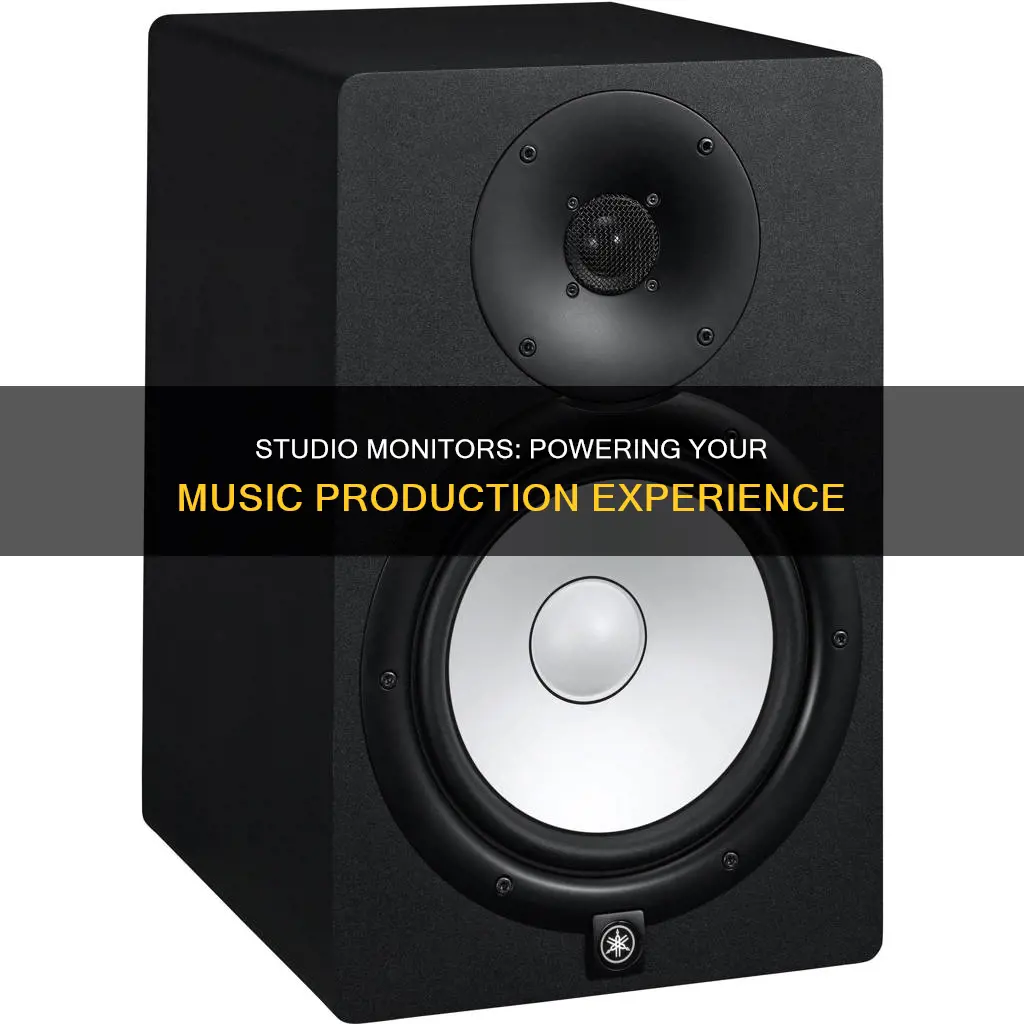
Studio monitors are a type of speaker used in recording, mixing, and mastering processes. They are designed to have a flat, precise sound profile, meaning they do not enhance or colour the sound in any way. This makes them ideal for critical listening and identifying sonic imperfections. Studio monitors are also designed for nearfield use, meaning they are placed a few feet away from the listener, providing a clear and immediate sound.
Powered studio monitors, also known as active monitors, have built-in amplifiers, while unpowered or passive monitors require an external amplifier. Active monitors are more convenient as they do not need an amp head and can be plugged directly into an electrical outlet. They are also designed for specific speakers, ensuring optimal sound performance.
When choosing powered studio monitors, it is important to consider the size of the monitors, the speaker configuration, and the application. For example, for recording hip-hop music with deep bass, a monitor with a large woofer is recommended. Additionally, the size of the studio space and the type of music being recorded should be taken into account.
| Characteristics | Values |
|---|---|
| Purpose | Critical listening, recording, mixing, mastering |
| Sound | Flat frequency response, precise, accurate, natural playback |
| Power | Built-in power amplifiers |
| Speaker cones | Woofer (bass), midrange, tweeter (treble) |
| Speaker configuration | Single-amp, bi-amp, tri-amp |
| Use case | Small studio environments, bedrooms, studios, smaller areas |
| Comparison with powered speakers | Project sound to large areas, used for social gatherings, home audio, and home theatre |
| Comparison with regular speakers | Regular speakers are passive, powered by a dedicated standalone amplifier |
| Nearfield | Close to the user/listener, a few feet away |
| Mid-field | A few meters away |
| Far-field | Non-directional, aimed to fill a room |
What You'll Learn
- Studio monitors are built for critical listening, designed to sound precise and flat, without colouring the sound
- They are used for recording, mixing and mastering audio
- Studio monitors are active speakers, with built-in power amplifiers
- They are designed for nearfield use, meaning they are meant to be used close to the user/listener
- Powered studio monitors are a good choice for home stereo systems

Studio monitors are built for critical listening, designed to sound precise and flat, without colouring the sound
Studio monitors are designed for critical listening, which means they are built to highlight sonic imperfections so that they can be fixed. They are designed to sound precise and flat, without colouring the sound. This means that they do not emphasise any one frequency, giving the listener the most accurate impression of the mix. Studio monitors are used for nearfield use, meaning they are designed to be placed a few feet away from the listener, providing a clear, immediate sound.
Studio monitors are often active speakers, meaning they have built-in power amplifiers. This is in contrast to passive speakers, which receive power from a dedicated standalone amplifier. Active speakers, particularly studio monitors, tend to have multiple power amplifiers in one unit, with individual power amps for the woofer (bass), midrange and tweeter (treble) cones, resulting in a more precise sound.
The precise sound of studio monitors is also due to the use of crossovers, which split frequencies to ensure they go to the right driver (speaker). This adds clarity and precision, allowing the listener to hear every detail across the EQ range. Studio monitors are designed to have a flat frequency response, meaning they playback the audio recording exactly as intended without any coloration to the sound. This is important in professional environments related to audio recording and mixing, as it ensures that the speakers do not influence how the audio professional edits the music or sound.
Studio monitors are also designed to be used in specific spaces, such as bedrooms, studios and smaller areas. They are not designed to fill a large room with sound like powered speakers but are ideal for critical listening and professional audio work.
Theatre Mode: ASUS Monitor's Unique Feature Explained
You may want to see also

They are used for recording, mixing and mastering audio
Studio monitors are used for recording, mixing, and mastering audio. They are designed for critical listening, allowing users to pick out and fix sonic imperfections. Studio monitors are built to behave differently from home cinema and hi-fi speakers, which are meant to sound good in any space. Studio monitors, on the other hand, are meant to sound "bad" in order to facilitate critical listening and audio editing.
Studio monitors are often used in recording studios, from bedroom studios to world-class facilities, and play a crucial role in the recording process. They help ensure that the speakers themselves do not influence how the audio professional edits the music or sound. Studio monitors provide a flat, precise sound, making them ideal for nearfield use, meaning they are placed a few feet away from the user. This setup prevents natural reverberations from affecting the sound and provides a clear, immediate impression of the mix.
In the mixing process, studio monitors are used to analyse different aspects of the mix and produce audio that translates well across different listening environments. Mixing engineers may use both headphones and studio monitors to ensure that the audio sounds consistent in various settings. Studio monitors are also useful for mixing as they provide a flat-response sound, maintaining the 'true' frequencies of the audio without enhancing or colouring it. This feature is especially important for professionals who need to mix, edit, and master audio to a high standard.
While studio monitors are commonly used for mixing, it is worth noting that some mastering studios opt for audiophile-grade stereo speakers instead of traditional studio monitors. This choice may seem like a paradox, as stereo speakers are typically advised against for mixing due to their coloration. However, mastering studios require a reliable and honest monitoring system, and in some cases, stereo speakers can provide a more accurate representation of the audio.
Adjusting Screen Size: Reducing Monitor Display for Better Viewing
You may want to see also

Studio monitors are active speakers, with built-in power amplifiers
Studio monitors are active speakers with built-in power amplifiers. This means they don't require power from an external amplifier, as do passive speakers, which are generally home hi-fi speakers. Studio monitors are designed to be powered directly from an electrical outlet, making them a convenient choice for studios that don't have an amplifier head.
Studio monitors are crafted for short-distance listening, making them ideal for small spaces such as bedrooms, studios, and smaller areas. They are designed for critical listening, aiming to reproduce a flat frequency response without colouring the sound. This means that they don't emphasise any particular frequency, allowing audio professionals to accurately edit and mix music without the speakers influencing the sound.
Active studio monitors have built-in amplification, making them simple to add to an existing setup. They offer simplicity, high quality, and affordability, and can deliver incredible sound that rivals systems with dedicated subwoofers. The amplification in a powered monitor is designed specifically for the speakers, ensuring optimal performance.
Studio monitors tend to have multiple power amplifiers in one unit, with individual power amps for the woofer (bass), midrange, and tweeter (treble) cones, resulting in a more precise sound. A crossover further enhances this precision by splitting frequencies to ensure they reach the correct driver (speaker).
Monitoring Server Performance: JMeter's Essential Role
You may want to see also

They are designed for nearfield use, meaning they are meant to be used close to the user/listener
Studio monitors are designed for near-field use, meaning they are meant to be used at close range to the user or listener. This is in contrast to far-field speakers, which are designed for larger spaces and have a larger "sweet spot" where listeners can hear an accurate frequency response. Near-field monitors are typically used in small studios or bedrooms and are placed closer to the listener, usually on a desk, whereas far-field speakers are often mounted farther back in the room.
The main difference between near-field and far-field speakers is their output and sound dispersion. Near-field monitors, even with smaller drivers, can produce a high sound power capability, but they are not designed for mid or far-field use as they may not have enough bass extension. They have a more directional sound, especially in the tweeters, resulting in a highly accurate frequency response in a small "sweet spot". Far-field speakers, on the other hand, tend to throw the sound out in a more omnidirectional pattern, resulting in a slightly less defined sound but with a larger "sweet spot".
The line between near-field and mid-field monitors is not well-defined, and it can vary depending on the room size. Near-field monitors are more room-agnostic and do not require as much design consideration with the room. They are also usually active, meaning the amplification is built into the speaker, making them a simpler choice for those setting up a studio.
When choosing between near-field and far-field speakers, it is important to consider the intended use and the size of the room. Near-field monitors are ideal for small spaces and for users who will be sitting close to the speakers, such as at a desk. Far-field speakers are better suited for larger spaces and for situations where multiple people need to hear an accurate frequency response, such as in a group recording session or when showing a mix to clients.
Cleaning Your LCD Monitor: Alcohol as a Safe Option
You may want to see also

Powered studio monitors are a good choice for home stereo systems
Powered studio monitors are a great choice for home stereo systems. They are designed to provide an accurate, uncoloured representation of music, ensuring that your mix will translate well across different listening systems. Studio monitors are typically used for critical listening, allowing you to identify and fix any sonic imperfections in your recordings.
One of the key advantages of powered studio monitors is their built-in amplifier, eliminating the need for a separate amplifier head. This makes them ideal for home stereo systems as you can simply plug them into an electrical outlet and connect them to your audio source. The built-in amplifier is specifically designed for the speakers, resulting in optimal sound quality.
When choosing powered studio monitors for your home stereo system, consider the size of your room and the type of music you'll be listening to. If you have a small room, opt for compact monitors, while larger rooms may require bigger monitors. Additionally, if you listen to music with deep bass, look for monitors with larger woofers to handle those low frequencies effectively.
Powered studio monitors offer flexibility in terms of placement. For the most accurate frequency response and stereo imaging, place them at an equal distance from each other and from your listening position, forming an equilateral triangle. To further enhance the sound, consider using speaker stands to isolate the monitors from the surface they are placed on.
It's worth noting that studio monitors are designed for nearfield use, meaning they are meant to be placed a few feet away from the listener. This ensures a clear and immediate sound without the natural reverberations that occur when moving around the room.
While studio monitors excel in accuracy and precision, they may not be as visually appealing for home listening as regular speakers. The sound quality may change as you move around the room, which is something to consider if you prefer casual listening while moving around your home.
In summary, powered studio monitors offer accuracy, convenience, and flexibility for home stereo systems. They provide an honest representation of your music, allowing you to fine-tune your recordings. With their built-in amplifiers and ease of use, they are an excellent choice for audiophiles and anyone looking for high-quality sound in their home stereo setup.
Connecting DDJ-SB2 to Studio Monitors: A Beginner's Guide
You may want to see also
Frequently asked questions
Powered studio monitors are speakers designed to reproduce sound accurately in situations where every note, sample, and vocal is crucial. They have built-in amplifiers, so they don't need an amp head to power them. This makes them a convenient option for studios that don't have amplifier heads readily available.
Powered studio monitors offer ease of use as they can be plugged directly into an electrical outlet and audio source without requiring a separate amplifier. The built-in amplifier is specifically designed for the speakers, ensuring optimal sound quality. They are ideal for critical listening, recording, mixing, and mastering audio, as they provide a flat, precise sound response.
When choosing powered studio monitors, consider the size of your studio and the type of music you'll be working with. For a small studio, compact monitors are sufficient, while larger studios or stereo speaker setups may require bigger monitors. Additionally, match the speaker configuration to the music genre; for example, choose monitors with large woofers for music with deep bass.







